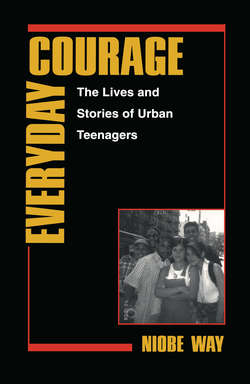Читать книгу Everyday Courage - Niobe Way - Страница 25
На сайте Литреса книга снята с продажи.
Strategies
ОглавлениеMy colleagues and I conducted semistructured interviews as our method of inquiry. The adolescents were first interviewed when they were in the ninth or tenth grade and then twice more in the two succeeding years. My colleague Helena Stauber and I interviewed all of the girls and some of the boys, while Mike Nakkula, Stacy Scott, and Jamie Aronson interviewed most of the boys.5 We tried to match interviewee and interviewer by gender in the belief that this would enhance the possibility of eliciting open and honest responses from the adolescents. Our experience eventually suggested, however, that this was not necessarily the case. Some of the boys specifically stated that they would feel more comfortable being interviewed by a woman and, subsequently, we accommodated their preference. Given my belief that continuity over time would enhance the quality of the interviews, I also tried to have each adolescent interviewed by the same interviewer each year. Due to scheduling difficulties, only ten of the adolescents were interviewed by the same interviewer during all three of their interviews. The remaining interviewees typically had the same interviewer in at least two of their three interviews.
The interviews were open-ended and lasted from one to two hours; during the third-year interviews, they typically lasted between two and three hours. The interviews took place in the school—any available space we could find—during lunch periods, class periods, after school, and, in a few cases, during the weekends. The weekend interviews took place in a community-based health clinic down the street from the school. The interview protocol included questions concerning self-perspectives; the future; drug and alcohol use; relationships with parents, siblings, best friends, romantic partners, and role models; and perspectives about school as well as the larger surrounding community (see Appendix A for interview protocol). Although each interview included a standard set of initial questions, follow-up questions were open-ended in order to capture the adolescents’ own ways of describing their lives. I wanted to find out how, why, and when these adolescents think, feel, or act with respect to the topics we were exploring.
To provide incentive for the students to participate, we paid them ten dollars for each interview. However, we realized after the first year of interviews that a greater incentive for some of the students was the opportunity to miss classes. While we tried to avoid having them miss core classes, inevitably they ended up missing all types—from gym to science. Teachers occasionally balked at our intrusiveness and were understandably unhappy about their students’ absences. To thank teachers for their cooperation and to give something back to them, we devoted time each week to helping them with difficult students. We ended up having good relationships with a small group of teachers who helped us find students and spaces for us to conduct the interviews. An ongoing difficulty with conducting school-based research studies is finding time to conduct interviews with students when the students are willing to do them and when the teachers will allow them to be done. In the end, however, we were able to interview all but one of the adolescents over three years (one student was only interviewed over two years). All interviews were tape-recorded and transcribed by a professional transcriber. Once the interviews were transcribed, the analytic process began.
In order to begin to make sense of what amounted eventually, after three years, to seventy-one interviews—each approximately forty to fifty pages in length—I sought immediate help from other qualitative researchers. While there is some consistency in the ways in which qualitative researchers collect interview data, there is little consistency in the ways in which they analyze it. After spending considerable time in the vast amount of literature on analyzing qualitative data, I decided to apply three data-analytic methods. These methods seemed the most effective in helping me sort, categorize, thematize, and understand the piles of data lying on my office floor. The methods, which I will describe below, were “The Listening Guide”;6 narrative summaries;7 and a content analysis using conceptually clustered matrices.8 As most qualitative researchers do, I revised slightly each method to fit this particular project. The integration of three revised methods, each emphasizing different aspects of the text, allowed me a detailed examination of the interview data.
